Social License to Operate in Geothermal Energy
Abstract
:1. Introduction
2. Social License to Operate (SLO): A Literature Review
2.1. The Nature of SLO
2.1.1. A Multilevel and Multiscale Construct
2.1.2. SLO—A Trust and Legitimacy Tandem
2.1.3. A Measurable Concept
2.2. How Is SLO Used and Acquired?
- How is “the community” defined? Is there a strict geographical limitation to “community”, and are elected officials given greater or equal status to local citizens?
- If there is a lack of consensus within the “community,” what process validates any decision-making (i.e., a majority vote of the local governing body; a referendum)?
- Third item. Absent a political process, what exactly represents an adequate level of consent?
2.3. SLO Theoretical Frameworks
- Socio-political acceptance: general social acceptance of policies and technologies by the public, key stakeholders, media, and policymakers.
- Community acceptance: acceptance of specific projects and locations by local stakeholders such as residents and local authorities.
- Market acceptance: wider market response to an innovation (involved actors are consumers, investors, and producers).
- the legal license aspect, which pertains to the current legislation;
- the economic license aspect, granted by the market and investors;
- the social license aspect, granted by a range of stakeholders who albeit unofficially, enforce compliance.
2.3.1. Social Acceptance and Social License to Operate
2.3.2. Building and Maintaining the SLO
3. Methods
4. Results
4.1. Social License to Operate for Geothermal Energy
4.2. Conceptualizing SLO in Geothermal Energy—A CROWDTHERMAL Study
4.2.1. Stakeholders Identification
- Government institutions,
- Academic institutions,
- Power industry (important in some countries, where high-enthalpy resources are already exploited or where a high potential is expected),
- Industry, private companies,
- Public,
- Non-governmental organizations (NGOs).
4.2.2. Stakeholders’ Issues and Concerns
4.2.3. Creation of Mutual Benefits
4.2.4. Impacts: Tangible and Intangible
- Risk of groundwater contamination;
- Land subsidence and deformation;
- Visual/noise pollution;
- Emissions (degassing and blow-out) and non-condensable gasses (NCGs) (e.g., CO2, H2S, NH3);
- Induced seismicity and land subsidence among the major negative acceptance factors;
- Visual impact and increased noise levels.
4.3. Conceptual Framework for SLO in Geothermal Energy
4.4. CROWDTHERMAL Case Studies: Challenges and Lessons Learned
4.4.1. Spain
“The commitment of the cooperative members allowed to take the project to the end without making changes on it, despite the difficulties and the attempts to modify it.”
“Involving an expert or consultant with deep knowledge on geothermal and the project itself as well as the minimum performance required, who is able to defend and stand for cooperative members’ interests during the whole project was an indispensable part of our project implementation process.”
“As this model was the base of the whole project, the integration of the geothermal system was immovable for cooperative members.”
4.4.2. Hungary
“… producing thermal fluids from and injecting them into the same aquifer might be a sustainable practice, but with widely disseminated examples of failed attempts at injection into Upper Pannonian sandstone, mitigating risks is critical and both the construction and the operation of injection wells need to follow strict protocols, and have to utilize state-of-the-art know-how to be successful and to ease anxieties over such installations.”
“…significantly increasing the production of the Hungarian-Serbian cross-border geothermal reservoir is a political and environmental issue, which needs to be addressed from the aspects of diplomatic protocol on the one hand and dynamic water-base monitoring on the other.”
“… with utility costs of private households fixed by law in Hungary, changing costs of primary energy do not affect heating bills. This results in the end-users being uninterested in switching to renewable, as high investment costs will not get balanced by lower heating bills. Thus, it becomes increasingly important to highlight the environmental advantages of geothermal.”
“…drilling 9 production and injection well-triplets and laying pipelines in a densely populated city is a significant annoyance for inhabitants, and a major technological and PR challenge during planning and execution.”
“This is our 6th geothermal District Heating (DH) project in the region: what’s new this time is that Szeged is by far the biggest city in the region, and interactions with the locals are frequent. In smaller towns, picking a well location away from the houses was easy—this time we are literally 40–50 m away from 4-10 storey buildings and we cause a lot of disturbance.”
4.4.3. Iceland
“People are happy that something is happening in their society and are happy to participate in discussions on the matter. I guess, in the next phase, when we start to hammer out more precisely the project itself, it will be more difficult to keep people’s engagement. We definitely learned about the importance of engaging the community. That has been our biggest focus.”
4.5. Mitigation Strategies
4.5.1. Co-Production and Technical Solutions
4.5.2. Intersections between SLO and Impact Assessment (IA)
4.5.3. Dialogue and Community Engagement
4.5.4. Negotiation and Politics
5. Concluding Remarks
Author Contributions
Funding
Institutional Review Board Statement
Informed Consent Statement
Data Availability Statement
Acknowledgments
Conflicts of Interest
Nomenclature
| SLO | Social License to Operate |
| IA | Impact Assessment |
| DHC | Domestic Hot Water |
| RETs | Renewable Energy Technologies |
| NCGs | Non-Condensable Gases |
| EIA | Environmental Impact Assessment |
| NGOs | Non-Governmental Organizations |
| DH | District Heating |
| KEHOP | Environmental and Energy Efficiency Operative Programme in Hungary |
| ERDF | European Regional Development Fund |
| GSHP | Ground Source Heat Pump |
| EU | European Union |
| CCS | Carbon Capture and Storage |
| UN | United Nations |
| UNGP | United Nations Guiding Principles |
| NIMBY | Not in My Back Yard |
References
- Moya, D.; Aldás, C.; Kaparaju, P. Geothermal energy: Power plant technology and direct heat applications. Renew. Sustain. Energy Rev. 2018, 94, 889–901. [Google Scholar] [CrossRef]
- Focaccia, S.; Tinti, F.; Monti, F.; Amidei, S.; Bruno, R. Shallow geothermal energy for industrial applications: A case study. Sustain. Energy Technol. Assess. 2016, 16, 93–105. [Google Scholar] [CrossRef]
- Palomo-Torrejón, E.; Colmenar-Santos, A.; Rosales-Asensio, E.; Mur-Pérez, F. Economic and environmental benefits of geothermal energy in industrial processes. Renew. Energ. 2021, 174, 134–146. [Google Scholar] [CrossRef]
- Barasa Kabeyi, M.J. Geothermal Electricity Generation, Challenges, Opportunities and recommendations. IJASRE 2019, 5, 53–95. [Google Scholar] [CrossRef]
- IEA. Technology Roadmap—Geothermal Heat and Power; International Energy Agency: Paris, France, 2011. [Google Scholar]
- Axelsson, G. Sustainable Management of Geothermal Resources. In Proceedings of the SDG Short Course I on Sustainability and Environmental Management of Geothermal Resource Utilization and the Role of Geothermal in Combating Climate Change, UNU-GTP and LaGeo, Santa Tecla, El Salvador, 4–10 September 2016. [Google Scholar]
- Dowd, A.M.; Boughen, N.; Ashworth, P.; Carr-Cornish, S. Geothermal technology in Australia: Investigating social acceptance. Energy Policy 2011, 39, 6301–6307. [Google Scholar] [CrossRef]
- Ellsworth, W.L. Injection-Induced Earthquakes. Science 2003, 341, 6142. [Google Scholar] [CrossRef]
- Giardini, D. Geothermal quake risks must be faced. Nature 2009, 462, 848–849. [Google Scholar] [CrossRef]
- Mignan, A.; Karvounis, D.; Broccardo, M.; Wiemer, S.; Giardini, D. Including seismic risk mitigation measures into the levelized cost of electricity in enhanced geothermal systems for optimal siting. Appl. Energy 2019, 238, 850. [Google Scholar] [CrossRef]
- Tian, T.; Huang, S. Study of environmental impact in geothermal development and utilization. In Proceedings of the 7th Asian Geothermal Symposium, Qingdao, China, 25–26 July 2006; pp. 35–44. [Google Scholar]
- DiPippo, R. Environmental impact of geothermal power plants. In Geotherm Power Plants, 4th ed.; DiPippo, R., Ed.; Butterworth Heinemann: Oxford, UK, 2016; pp. 657–684. [Google Scholar] [CrossRef]
- Li, Y.; Zhang, Z.; Li, Z.; Luo, Y.; Jiang, W.; Tian, Y. Measurement of subsidence in the Yangbajing geothermal fields, Tibet, from TerraSAR-X InSAR time series analysis. Int. J. Digit. Earth 2016, 9, 697–709. [Google Scholar] [CrossRef]
- Rathnaweera, T.D.; Wu, W.; Ji, Y.; Gamage, R.P. Understanding injection-induced seismicity in enhanced geothermal systems: From the coupled thermo-hydro-mechanical-chemical process to anthropogenic earthquake prediction. Earth Sci. Rev. 2020, 205, 103182. [Google Scholar] [CrossRef]
- Soltani, M.; Kashkooli, F.M.; Souri, M.; Rafiei, B.; Jabarifar, M.; Gharali, K.; Nathwani, J. Environmental, economic, and social impacts of geothermal energy systems. Renew. Sustain. Energy Rev. 2021, 140, 110750. [Google Scholar] [CrossRef]
- DiPippo, R. Geothermal Power Plants: Principles, Applications, Case Studies and Environmental Impact; Butterworth-Heinemann: Oxford, UK, 2012. [Google Scholar]
- Study on Public Perception of Geothermal Energy. Geothermal Communities Project. GeoCom—FP7 CONCERTO—239515, Deliverable 6.1. Available online: https://geothermalcommunities.eu/downloads/15 (accessed on 8 December 2021).
- Ruef, F.; Ejderyan, O. Rowing, steering or anchoring? Public values for geothermal energy governance. Energy Policy 2021, 158, 112577. [Google Scholar] [CrossRef]
- Poortinga, W.; Aoyagi, M.; Pidgeon, N.F. Public perceptions of climate change and energy futures before and after the Fukushima accident: A comparison between Britain and Japan. Energy Policy 2013, 62, 1204–1211. [Google Scholar] [CrossRef]
- Bidwell, D. Thinking through participation in renewable energy decisions. Nat. Energy 2016, 1, 16051. [Google Scholar] [CrossRef]
- Walker, C.; Stephenson, L.; Baxter, J. His main platform is ‘stop the turbines’: Political discourse, partisanship and local responses to wind energy in Canada. Energy Policy 2018, 123, 670–681. [Google Scholar] [CrossRef]
- Wallquist, L.; Holenstein, M. Stakeholderanalyze Geothermie: Analyse von Einstellungen und Wahrnehmungsprozessen. Stiftung Risiko-Dialog on Behalf of Enerchange. 2012. Available online: https://www.risiko-dialog.ch/wp-content/uploads/2020/03/Geothermie_BMU_Stakeholderanalyse_SRD_20120717.pdf (accessed on 8 December 2021).
- Benighaus, C.; Bleicher, A. Neither risky technology nor renewable electricity: Contested frames in the development of geothermal energy in Germany. Energy Res. Soc. Sci. 2019, 47, 46–55. [Google Scholar] [CrossRef]
- Reith, S.; Kölbel, T.; Schlagermann, P.; Pellizzone, A.; Allansdottir, A. Public Acceptance of Geothermal Electricity Production; GEOELEC Deliverable No. 44; EnBW Energie Baden-Württemberg AG: Karlsruhe, Germany, 2013. [Google Scholar]
- Vargas Payera, S. Understanding social acceptance of geothermal energy: Case study for Araucanía region, Chile. Geothermics 2018, 72, 138–144. [Google Scholar] [CrossRef]
- Devine-Wright, P. Renewable Energy and the Public: From NIMBY to Participation; Earthscan Publications Ltd.: London, UK, 2011. [Google Scholar]
- Devine-Wright, P. Rethinking NIMBYism: The role of place attachment and place identity in explaining place-protective action. J. Community Appl. Soc. Psychol. 2009, 19, 426–441. [Google Scholar] [CrossRef]
- Cousse, J.; Trutnevyte, E.; Hahnel Ulf, J.J. Tell me how you feel about geothermal energy: Affect as a revealing factor of the role of seismic risk on public acceptance. Energy Policy 2021, 158, 112547. [Google Scholar] [CrossRef]
- Chavot, P.; Heimlich, C.; Masseran, A.; Serrano, Y.; Zoungrana, J.; Bodin, C. Social shaping of deep geothermal projects in Alsace: Politics, stakeholder attitudes and local democracy. Geotherm. Energy 2018, 6, 26. [Google Scholar] [CrossRef]
- Pivot 2020—Kicking off the Geothermal Decade! Geothermal Entrepreneurship Organization (GEO). Online Event on 13–17 July 2020. Available online: https://www.texasgeo.org/pivot2020 (accessed on 10 December 2021).
- European Geothermal Council. Geothermal Decade. 2020. Available online: https://www.egec.org/geothermal-decade-2/ (accessed on 10 December 2021).
- Hall, N.; Lacey, J.; Carr-Cornish, S.; Dowd, A.-M. Social licence to operate: Understanding how a concept has been translated into practice in energy industries. J. Clean. Prod. 2015, 86, 301–310. [Google Scholar] [CrossRef]
- Missing Lobbyists and a Social License for Geothermal—Insights by Marit Brommer, Exec. Director, IGA. Heat Beat Blog via ThinkGeoEnergy. 2020. Available online: https://www.thinkgeoenergy.com/missing-lobbyists-and-a-social-license-for-geothermal-insights-by-marit-brommer-exec-director-iga/ (accessed on 10 September 2021).
- CROWDTHERMAL Project Consortium. Available online: https://www.crowdthermalproject.eu/ (accessed on 1 September 2019).
- Taylor, D.F.P.; Mahlangu, S. Earning the Social Licence to Operate—A casestudy about culture. In Proceedings of the 5th International Conference on Management, Leadership and Governance, Johannesburg, South Africa, 16–17 March 2017. [Google Scholar]
- Gunningham, N.; Kagan, R.A.; Thornton, D. Social License and Environmental Protection: Why Businesses Go Beyond Compliance. Law Soc. Inq. 2004, 29, 307–341. [Google Scholar] [CrossRef]
- Moffat, K.; Zhang, A. The paths to social licence to operate: An integrative model explaining community acceptance of mining. Resour Policy 2014, 39, 61–70. [Google Scholar] [CrossRef] [Green Version]
- Voyer, M.A.; van Leeuwen, J. Social license to operate in the Blue Economy. Resour Policy 2019, 62, 102–113. [Google Scholar] [CrossRef]
- Smits, C.C.A.; Justinussen, J.C.S.; Bertelsend, R.G. Human capital development and a Social License to Operate: Examples from Arctic energy development in the Faroe Islands, Iceland and Greenland. Energy Res. Soc. Sci. 2016, 16, 122–131. [Google Scholar] [CrossRef] [Green Version]
- Wang, S. Managing Canada’s forests under a new social contract. For. Chron. 2005, 81, 486–490. [Google Scholar] [CrossRef]
- Williams, J.; Martin, P.V. Defending the Social License of Farming: Issues, Challenges and New Directions for Agriculture; Williams, J., Martin, P.V., Eds.; CSIRO Publishing: Collingwood, Australia, 2011; p. 206. [Google Scholar]
- Carr-Cornish, S.; Romanach, L. Exploring Community Views toward Geothermal Energy Technology in Australia; CSIRO: Pullenvale, Australia, 2012. [Google Scholar]
- Corvellec, H. Arguing for a license to operate: The case of the Swedish wind power industry. Corp. Commun. 2007, 12, 129–144. [Google Scholar] [CrossRef] [Green Version]
- Hall, N.; Ashworth, P.; Devine-Wright, P. Societal acceptance of wind farms: Analysis of four common themes across Australian case studies. Energy Policy 2013, 58, 200–208. [Google Scholar] [CrossRef]
- Buhmann, K. Public Regulators and CSR: The ‘Social Licence to Operate’ in Recent United Nations Instruments on Business and Human Rights and the Juridification of CSR. J. Bus. Ethics 2015, 136, 699–714. [Google Scholar] [CrossRef] [Green Version]
- Lacey, J.; Parsons, R.; Moffat, K. Exploring the Concept of a Social Licence to Operate in the Australian Minerals Industry: Results from Interviews with Industry Representatives; EP12553; CSIRO: Brisbane, Australia, 2012. [Google Scholar]
- Thomson, I.; Boutilier, R. The social license to operate. In SME Mining Engineering Handbook, 3rd ed.; Darling, P., Ed.; Society for Mining, Metallurgy, and Exploration: Englewood, CO, USA, 2011; pp. 1779–1796. [Google Scholar]
- Mercer-Mapstone, L.; Rifkin, W.; Moffat, K.; Louis, W. Conceptualising the role of dialogue in social licence to operate. Resour. Policy 2017, 54, 137–146. [Google Scholar] [CrossRef]
- International Council of Mining and Metals. Council for Mining and Metals (ICMM). ICMM Position Statement on Indigenous Peoples and Mining; ICMM: London, UK, 2013. [Google Scholar]
- Wilburn, K.; Wilburn, R. Achieving social license to operate using stakeholder theory. J. Bus. Ethics 2011, 3, 16. [Google Scholar]
- Luning, S. Corporate Social Responsibility (CSR) for exploration: Consultants, companies and communities in processes of engagement. Resour. Policy 2012, 37, 205–211. [Google Scholar] [CrossRef]
- Lacey, J.; Lamont, J. Using social contract to inform social licence to operate: An application in the Australian coal seam gas industry. J. Clean. Prod. 2014, 84, 831–839. [Google Scholar] [CrossRef]
- Van Putten, I.E.; Cvitanovic, C.; Fulton, E.; Lacey, J.; Kelly, R. The emergence of social licence necessitates reforms in environmental regulation. Ecol. Soc. 2018, 3, 24. [Google Scholar] [CrossRef] [Green Version]
- Edwards, P.; Fleming, A.; Lacey, J.; Lester, L.; Pinkard, E.; Ruckstuhl, K.; Bezuidenhout, C.; Payn, T.; Bayne, K.; Willimans, T. Trust, engagement, information and social licence—insights from New Zealand. Environ. Res. Lett. 2019, 14, 024010. [Google Scholar] [CrossRef] [Green Version]
- Jartti, T.; Litmanen, T.; Lacey, J.; Moffat, K. National level paths to the mining industry’s Social Licence to Operate (SLO) in Northern Europe: The case of Finland. Extract. Ind. Soc. 2020, 7, 97–109. [Google Scholar] [CrossRef]
- Franks, D.M.; Cohen, T. Social licence in design: Constructive technology assessment within a mineral research and development institution. Technol. Forecast. Soc. Chang. 2012, 7, 1229–1240. [Google Scholar] [CrossRef]
- Santiago, A.L.; Demajorovic, J.; Rossetto, D.E.; Luke, H. Understanding the fundamentals of the Social Licence to Operate: Its evolution, current state of development and future avenues for research. Resour. Policy 2021, 70, 101941. [Google Scholar] [CrossRef]
- Yates, B.F.; Horvath, C.L. Social License to Operate: How to Get It, and How to Keep It. In Proceedings of the 2013 Pacific Energy Summit, Vancouver BC, Canada, 2–4 April 2013. [Google Scholar]
- Asmus, P. When It Comes to Water, Can Corporations and Community Really Coexist? Available online: http://peaceandjustice.org/article.php/20090820081745528 (accessed on 19 January 2021).
- Gehman, J.; Lefsrud, L.; Fast, S. Social License to Operate: Legitimacy by another Name? Can. Public Adm. 2017, 60, 293–317. [Google Scholar] [CrossRef] [Green Version]
- Boutilier, R.G.; Thomson, I. Modelling and Measuring the Social License to Operate: Fruits of a Dialogue between Theory and Practice. Available online: www.SocialLicence.com (accessed on 19 August 2021).
- Joyce, S.; Thomson, I. Earning a social licence to operate: Social acceptability and resource development in Latin America. Can. Min. Metall. Bull. 2000, 93, 1037. [Google Scholar]
- Thomson, I.; Joyce, S. The Social Licence to Operate: What It Is and Why Does It Seem So Difficult to Obtain? PDAC Convention. Available online: https://socialicense.com/publications/PDAC_2008_Social_Licence.pdf (accessed on 27 December 2020).
- Baumber, A.; Scerri, M.; Schweinberg, S. A social licence for the sharing economy. Technol. Forecast. Soc. Chang. 2019, 146, 12–23. [Google Scholar] [CrossRef]
- Wüstenhagen, R.; Wolsink, M.; Bürer, M.J. Social acceptance of renewable energy innovation: An introduction to the concept. Energy Policy 2007, 35, 2683–2691. [Google Scholar] [CrossRef] [Green Version]
- Jijelava, D.; Vanclay, F. Legitimacy, credibility and trust as the key components of a social licence to operate: An analysis of BP’s projects in Georgia. J. Clean. Prod. 2017, 140, 1077–1086. [Google Scholar] [CrossRef]
- Parsons, R.; Moffat, K. Constructing the Meaning of Social Licence. Soc. Epistemol. 2014, 3-4, 340–363. [Google Scholar] [CrossRef]
- Zhang, A.; Moffat, K. A balancing act: The role of benefits, impacts and confidence in governance in predicting acceptance of mining in Australia. Resour. Policy 2015, 44, 25–34. [Google Scholar] [CrossRef]
- Zhang, A.; Moffat, K.; Lacey, J.; Wang, J.; González, R.; Uribe, K.; Cui, L.; Dai, Y. Understanding the social licence to operate of mining at the national scale: A comparative study of Australia, China and Chile. J. Clean. Prod. 2015, 108, 1063–1072. [Google Scholar] [CrossRef]
- Gunningham, N.; Kagan, R.A.; Thornton, D. Shades of Green: Business, Regulation, and Environment. Can. J. Law Soc. 2003, 18, 153–155. [Google Scholar] [CrossRef]
- Kagan, R.A.; Gunningham, N.; Thornton, D. Explaining Corporate Environmental Performance: How Does Regulation Matter? Law Soc. Rev. 2003, 37, 51–90. [Google Scholar] [CrossRef]
- Thornton, D.; Kagan, R.A.; Gunningham, N. Sources of corporate environmental performance. Calif. Manag. Rev. 2003, 46, 127–141. [Google Scholar] [CrossRef] [Green Version]
- Morrison, J. The Social Licence: How to Keep your Organization Legitimate; Palgrave Macmillan: Basingstoke, UK, 2014. [Google Scholar]
- Conrad, J. The Social License to Operate and Social Contract Theory: Themes and Relations of Two Concepts—A Literature Analysis. Master’s Thesis, University of Iceland, Reykjavik, Iceland, September 2018. [Google Scholar]
- Braun, V.; Clarke, V. Thematic analysis. In Apa Handbook of Research Methods in Psychology: Research Design; Cooper, H., Ed.; American Psychological Association: Worcester, MA, USA, 2012; Volume 2, pp. 57–71. [Google Scholar]
- Prno, J.; Slocombe, D. A systems-based conceptual framework for assessing the determinants of a social license to operate in the mining industry. Environ. Manag. 2014, 53, 672–689. [Google Scholar] [CrossRef]
- Owen, J.R.; Kemp, D. Social licence and mining: A critical perspective. Resour. Policy 2013, 38, 29–35. [Google Scholar] [CrossRef]
- Hilderbrand, J.; Klein, K. Stakeholder and Case Study Analysis Report. Crowdthermal Project. Deliverable 1.3. 2020. Available online: https://www.crowdthermalproject.eu/wp-content/uploads/2020/11/D1.3_Stakeholder-and-case-study-analysis-report.pdf (accessed on 11 November 2020).
- Hilderbrand, J.; Rühmland, S.; Klein, K. International Review of Public Perception Studies. Crowdthermal Project. Deliverable 1.1. 2020. Available online: https://www.crowdthermalproject.eu/wp-content/uploads/2020/04/CROWDTHERMAL-D1.1_IZES.pdf (accessed on 3 March 2021).
- Carr-Cornish, S.; Romanach, L. Differences in public perceptions of geothermal energy technology in Australia. Energies 2014, 3, 1555–1575. [Google Scholar] [CrossRef] [Green Version]
- Moser, C.; Rösch, A.; Stauffacher, M. Exploring societal preferences for energy sufficiency measures in Switzerland. Front. Energy Res. 2015, 3, 40. [Google Scholar]
- Stauffacher, M. Risk governance for induced seismicity: A view from the social sciences. In Proceedings of the AGIS Workshop on Induced Seismicity, Schatzalp, Switzerland, 10–13 March 2015. [Google Scholar]
- Karytsas, S.; Karytsas, C.; Mendrinos, D. Towards social acceptance of geothermal energy power plants. In Proceedings of the European Geothermal Congress, Den Haag, The Netherlands, 11–14 June 2019. [Google Scholar]
- Vargas-Payera, S.; Martinez-Reyes, A.; Ejderyan, O. Factors and dynamics of the social perception of geothermal energy: Case study of the Tolhuaca exploration project in Chile. Geothermics 2020, 88, 101907. [Google Scholar] [CrossRef]
- Cataldi, R. Social Acceptance: A Must to foster Geothermal Development in Next Decades. In Proceedings of the International Seminar on “The Role of Geothermal Energy in Sustainable Development of Mazowsze and Lodz Regions, Poland”, Osuchòw, Poland, 4–6 October 2000. [Google Scholar]
- Gehman, J.; Thompson, D.; Alessi, D.; Allen, D.; Goss, G. Comparative analysis of hydraulic fracturing wastewater practices in unconventional shale development: Newspaper coverage of stakeholder concerns and social license to operate. Sustainability 2016, 8, 912. [Google Scholar] [CrossRef] [Green Version]
- AgentschapNL Infoblad Trias Energetica en Energieneutraal Bouwen. Zaken, A.M.v.E., Ed.. 2013. Available online: http://www.agentschapnl.nl/content/infoblad-trias-energetica (accessed on 19 October 2021).
- Bice, S.; Moffat, K. Social licence to operate and impact assessment. Impact Assess. Proj. Apprais. 2014, 4, 257–262. [Google Scholar] [CrossRef]
- Trutnevyte, E.; Ejderyan, O. Managing geoenergy-induced seismicity with society. J. Risk Res. 2018, 21, 1287–1294. [Google Scholar] [CrossRef]
- Zhang, A.; Measham, T.G.; Moffat, K. Preconditions for social licence: The importance of information in initial engagement. J. Clean. Prod. 2018, 172, 1559–1566. [Google Scholar] [CrossRef]
- Skoldeberg, J.; Jones, V.N.; Kupcu, M.F.; Cable, C. Changing the Game—Communications and Sustainability in the Mining Industry. Available online: https://commdev.org/publications/changing-the-game-communications-and-sustainability-in-the-mining-industry/ (accessed on 8 November 2020).
- Wilburn, R.; Wilburn, K. Social License to Operate as a Business Strategy. Organ. Cult. Int. J. 2014, 13, 21–32. [Google Scholar] [CrossRef]
- Karytsas, S.; Polyzou, O. Social acceptance of geothermal power plants. In Thermodynamic Analysis and Optimization of Geothermal Power Plants; Colpan, C.O., Ezan, M.A., Kizilkan, O., Eds.; Elsevier: Amsterdam, The Netherlands, 2021; pp. 65–79. [Google Scholar]
- Davidsdottir, B. Sustainable Energy Development: The Role of Geothermal Power; Comprehensive Renewable Energy; Sayigh, A., Ed.; Elsevier: Amsterdam, The Netherlands, 2012; pp. 273–297. [Google Scholar] [CrossRef]
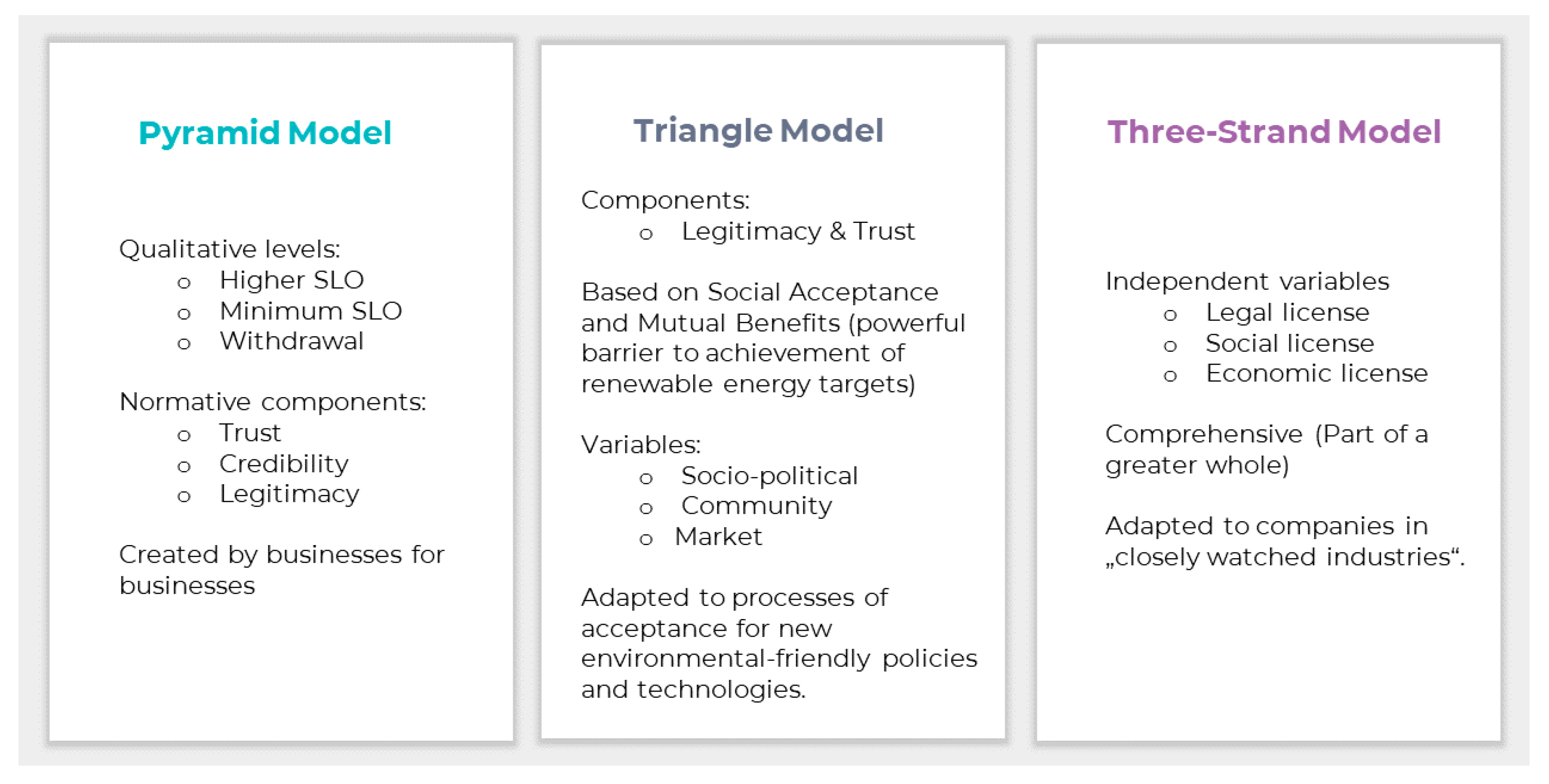
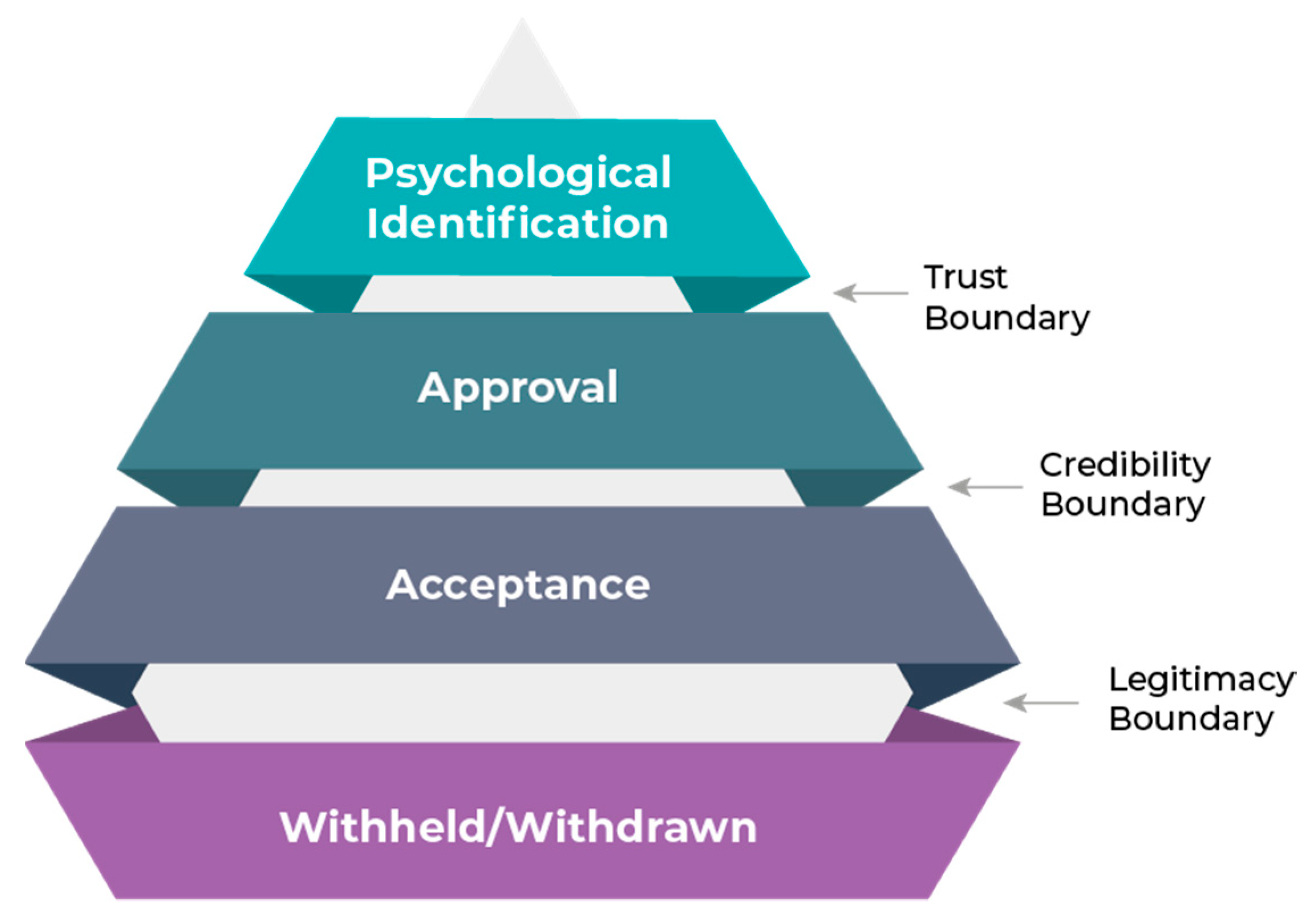

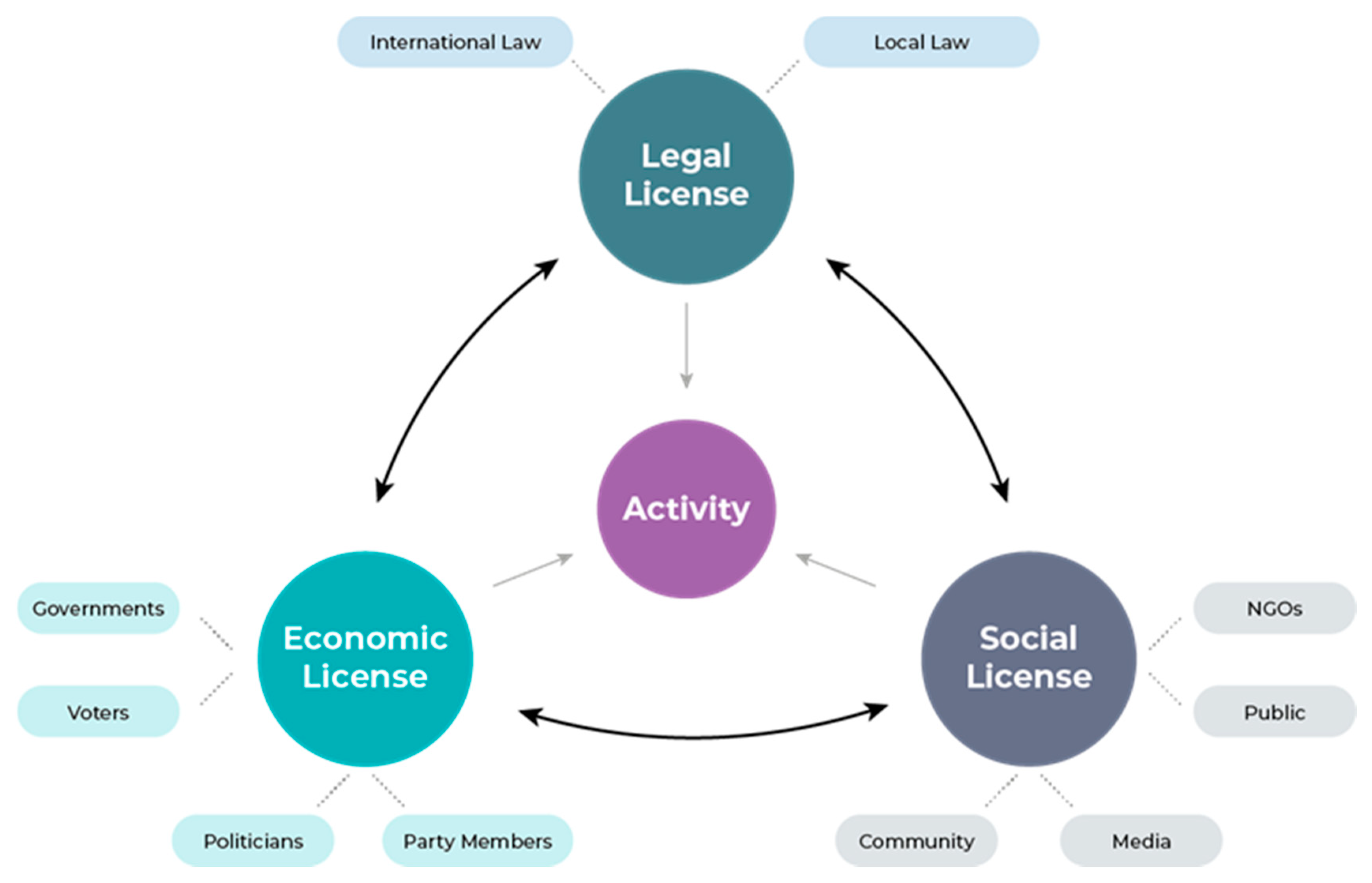
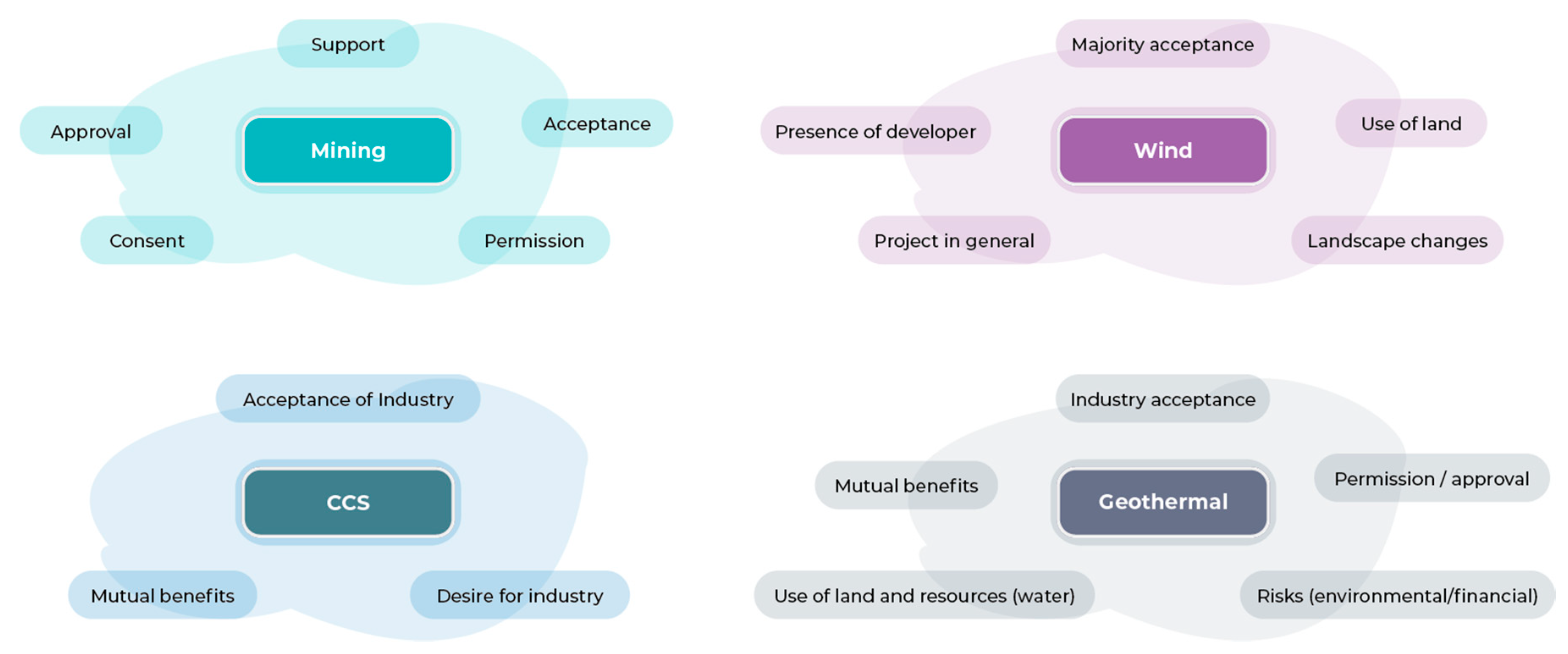
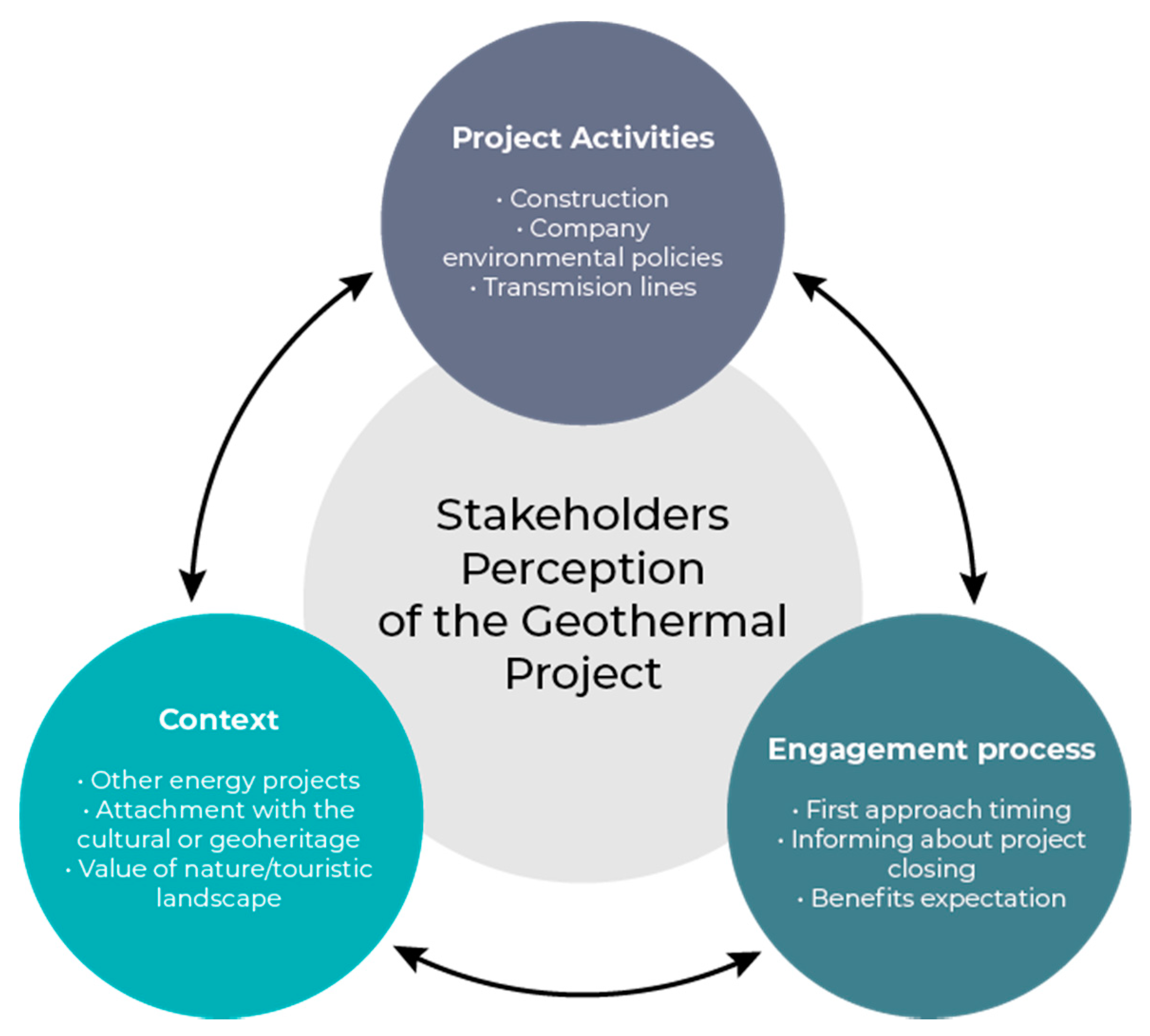
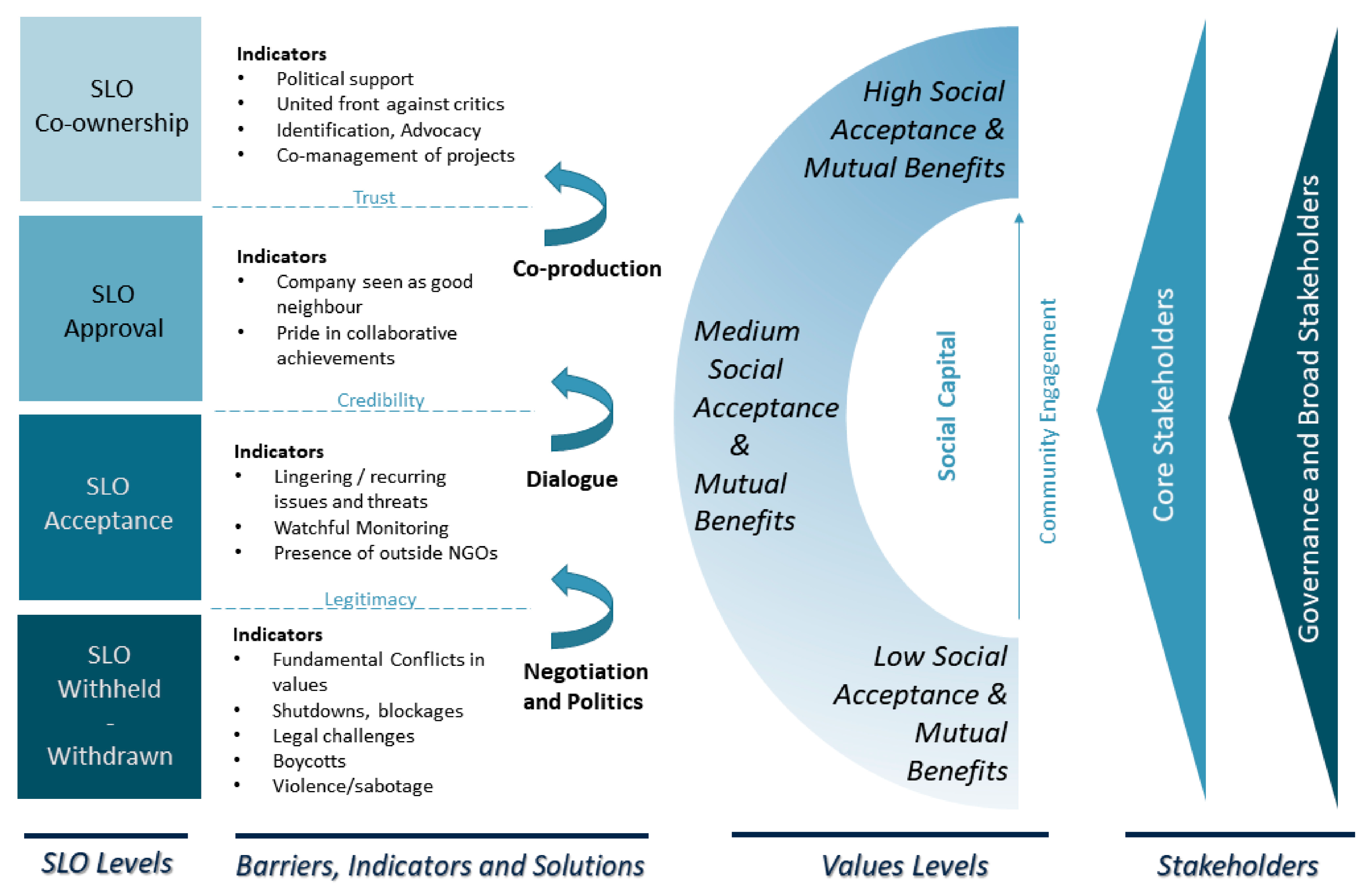
| 1. Definitions | 1.1. Function | 1.1.1. Organizational philosophy |
| 1.1.2. Tool | ||
| 1.2. Structure | 1.2.1. Pyramid | |
| 1.2.2. Triangle | ||
| 1.2.3. Three-strand | ||
| 2. Influencing factors | 2.1. Public involvement | 2.1.1. Dialogue |
| 2.1.2. Trust | ||
| 2.1.3. Co-production | ||
| 2.2. Mutual benefits | 2.2.1. Benefit sharing | |
| 2.2.2. Cost-Benefit balancing | ||
| 3. Impacts | 3.1. Positive local relation | 3.1.1. Psychological identification |
| 3.1.2. Approval | ||
| 3.1.3. Acceptance | ||
| 3.1.4. Social Capital |
Publisher’s Note: MDPI stays neutral with regard to jurisdictional claims in published maps and institutional affiliations. |
© 2021 by the authors. Licensee MDPI, Basel, Switzerland. This article is an open access article distributed under the terms and conditions of the Creative Commons Attribution (CC BY) license (https://creativecommons.org/licenses/by/4.0/).
Share and Cite
Barich, A.; Stokłosa, A.W.; Hildebrand, J.; Elíasson, O.; Medgyes, T.; Quinonez, G.; Casillas, A.C.; Fernandez, I. Social License to Operate in Geothermal Energy. Energies 2022, 15, 139. https://doi.org/10.3390/en15010139
Barich A, Stokłosa AW, Hildebrand J, Elíasson O, Medgyes T, Quinonez G, Casillas AC, Fernandez I. Social License to Operate in Geothermal Energy. Energies. 2022; 15(1):139. https://doi.org/10.3390/en15010139
Chicago/Turabian StyleBarich, Amel, Alicja W. Stokłosa, Jan Hildebrand, Ottó Elíasson, Tamás Medgyes, Gauthier Quinonez, Ana C. Casillas, and Isabel Fernandez. 2022. "Social License to Operate in Geothermal Energy" Energies 15, no. 1: 139. https://doi.org/10.3390/en15010139
APA StyleBarich, A., Stokłosa, A. W., Hildebrand, J., Elíasson, O., Medgyes, T., Quinonez, G., Casillas, A. C., & Fernandez, I. (2022). Social License to Operate in Geothermal Energy. Energies, 15(1), 139. https://doi.org/10.3390/en15010139






